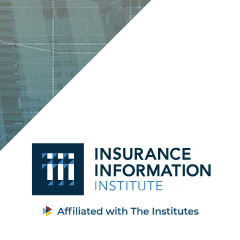
By Loretta Worters, Vice President, Media Relations, Triple-I
Costs associated with increasing lawsuits and “nuclear verdicts” continue to challenge insurers’ capacity to provide coverage, according to panelists at Triple-I’s Joint Industry Forum (JIF).

“Excessive growth in insurance settlements is top of mind for many,” said Frank Tomasello, J.D., executive director of The Institutes Griffith Insurance Education Foundation, who moderated the JIF Runaway Litigation panel. The panelists explored definitional issues and controversies surrounding this phenomenon and assessed its impact with a look ahead to what is needed to inform next steps.
“Certain observers dismiss runaway litigation, suggesting it’s a ‘phantom threat’ used to justify premium increases,” Tomasello said. “Industry leaders, however, point to data evidencing its existence in various lines of business, including commercial auto liability.”

Michael Menapace, an attorney with Wiggin and Dana LLP and a Triple-I Non-resident Scholar, noted that insurers’ claims expenses are increasing faster than inflation “due to a combination of increased litigation defense costs, higher percentage of plaintiff verdicts, and increased jury awards.”

Sherman (Tiger) Joyce, president of the American Tort Reform Association (ATRA), said the analysis should examine where litigation is having the greatest impact on expenses, whether it’s a line of business, type of litigation, or a geographic region. “Where is it real, where is it not? If it is real, why are defense costs up? Why are plaintiffs winning more?”
To offer guidance in this regard, the ATR Foundation publishes each year its list of Judicial Hellholes.
Rick Merrill, founder and CEO of Gavelytics, a litigation analytics software firm, said his company is well positioned to help answer these questions.

“We can’t do as well as insurers, who can speak to the cost side,” Merrill said. “They are better positioned to determine price; but where we can add value is in trying to understand why this has occurred.”
Merrill cautioned against reliance on anecdotes.
“The much more modern approach to litigation analysis is measuring things in an empirical fashion,” he said. “Understanding whether or not the rates of trial wins are up or down, understanding whether the grant rates of certain key motions are up or down, those are things we do, and that adds a lot to the conversation.”
Workers comp and commercial auto
Menapace noted that there are increased costs, particularly in workers compensation and commercial auto — specifically, trucking.
“After COVID started, we had more than a dozen states who implemented as a matter of policy a presumption that if a worker got sick with COVID, that it happened on the job,” Menapace explained. “The burden then shifted to the defendant/insurer to disprove that this happened. There was a public policy decision made in those states.”
In commercial auto, Menapace said, “We’re seeing in trucking and elsewhere the increased use of cameras – body cameras, cameras out in the public, dashboard cameras facing out or many trucking institutions now have cameras facing into the cab. Think about how powerful that might be in a court when, moments before the trucking accident, we now have on video the trucker who was checking Facebook, eating, or dozing off.
Reptile theory and litigation funding
Menapace also mentioned “reptile theory,” a popular plaintiff tactic in personal injury suits. Introduced in Reptile: the 2009 Manual of the Plaintiff’s Revolution by David Ball and Don Keenan, it started a movement that has evolved into seminars, retreats and law review articles aimed at understanding and exploiting the primitive, emotion-driven “reptile” portion of jurors’ brains.
Litigation funding – in which third-party investors assume all or part of the cost of a lawsuit exchange for an agreed-upon percentage of the settlement – is a growing issue that increases defense costs and the length of dispute, the experts said. According to a recent Bloomberg article, hedge funds and others “are piling billions into the outcome of high stakes court cases at a faster rate than ever before,” turning litigation funding into a $39 billion global industry in 2019. The panelists concurred that requiring disclosure of third-party funding of litigation would be a great benefit for the industry if it were to happen.
Learn More About Runaway Litigation on the Triple-I Blog
What Can Be Done About Nuclear Verdicts?
Litigation Funding and Social Inflation: What’s the Connection?
Litigation Funding Rises as Common-Law Bans Are Eroded by Courts











